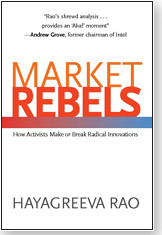
Market Rebels: How Activists Make or Break Radical Innovations
Havagreeva Rao
222 pages, Princeton University Press, 2008
Lost in many of the histories of Silicon Valley is the important role played by the Homebrew Computer Club. Founded in March 1975 (one month before Microsoft Corp.), the club was one of the cradles of the personal computing revolution about to sweep the United States. An avid group of people who enjoyed building their own computers and writing their own software, Homebrew eventually spawned 22 companies, including Apple Inc.
It is precisely this type of story that Hayagreeva Rao covers in his interesting new book, Market Rebels. For Rao, the untold story of economic change is the role of social movements in either promot-ing or suppressing innovations, often against stacked odds. He starts with the automobile. Rao sets out to defl ate what he says is popular mythology that Henry Ford created the auto industry. Instead, it was the myriad automobile clubs that sprang up between 1895 and 1910, holding demonstrations and reliability contests, that “established the car as a cultural category.” This is undoubtedly true, but Ford played no small role in the car’s popularity. The emerging culture, after all, needed an object to venerate. Ford provided that with the introduction of the Model T in 1908.
Rao’s next example is microbrewing: In 1980 there were eight microbrewers in the United States; by 2003, there were 1,492. What drove this extraordinary growth? “Evange-ale-ists,” says Rao: “Beer enthusiasts were rebels who constructed a hot cause (the atrocious taste of mass-produced beer) and relied on cool mobilization (small brewpubs using traditional methods and authentic artisanal techniques that offered distinctive beers and, therefore, added to cultural diversity).” Hot cause and cool mobilization are the intended catchphrases of the book—activists in each area unfreeze an equilibrium and refreeze a new one. It’s clever, but somehow feels forced.
In his presentation of social movements as an alternative to economic models, Rao caricatures economists as solely concerned with the iron invisible hand, not the “joined hands” that Rao celebrates. This is unfair. There are many economists concerned with the intricacies of economic behavior and its relation with larger social patterns. Rao simply dismisses Adam Smith’s invisible hand as irrelevant, drawing a distinction between individual and collective action. But his descriptions of auto enthusiasts and PC evangelists seem exactly like people pursuing their own self-interests, with the result that society is better off. And Smith was part of the Scottish Enlightenment, which not only influenced the founders of the American republic but also put much stock in the idea of spontaneous order. What are Rao’s social movements but examples of this?
In other words, Rao describes exactly the phenomenon of economic change, and we should be thankful that he has connected social and economic activities that are often treated separately. We speak of “the economy” as some disembodied mechanism that is malleable to our ministrations; we treat consumption of goods and services as if it were somehow shoved upon us by diabolical corporations. Yet, as Rao shows, much of what we call “the economy” is inseparable from everyday life. We enjoy the freedom (and pollution) of cars not because of that evil Henry Ford or scheming multinationals, but because a cadre of people were determined that they represented the future.
But not all is smooth sailing: The other side of what Rao’s market rebels do is “break” innovation. The two examples here are the anti-chain store and anti-biotechnology movements. In these instances, “weaker organizational forms” take on, through “nonmarket” strategies, more powerful organizations such as Wal-Mart Stores Inc. No one enjoys seeing independent stores shut down, but there is good evidence that chain stores bring huge benefits in employment and efficiency. Plus, once you realize that many anti-Wal-Mart groups are funded by unions, the heroic rebels vs. evil empire archetype fades a bit.
Slightly more complex is biotechnology. True, many questions of morality and safety remain, but there is also great promise in new types of drugs. Rao focuses on the activist groups that in the late 1980s and early 1990s drove biotechnology research out of Germany. No matter your position on biotechnology, it can be difficult to see equivalence between automobile enthusiasts and groups that use arson as a method of persuasion.
A cynical reviewer might say that Rao has simply discovered capitalism. In the 1940s, Joseph Schumpeter wrote of the “perennial gales of creative destruction” that buff et the established companies of any economy. For Schumpeter, too, this was as much a social as an economic phenomenon.
The narrative of economic growth is always one of challenges to established interests. In this sense, Rao’s book appears at just the right time, when questions about whether and how to bail out entrenched interests— carmakers, financial conglomerates—are persistent. Rao’s answer, which he may not even see, is a resounding no: allow the rebellious hordes to save our economy

